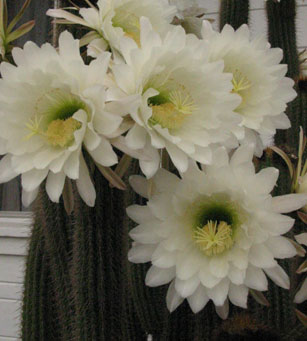Something remarkable occured on the corner of San Jose and Santa Clara Avenues a few days ago – a miraculous pairing of opposites in the blooming of the Trichocereus spachianus cactus…
 Something remarkable occured on the corner of San Jose and Santa Clara Avenues a few days ago…
Something remarkable occured on the corner of San Jose and Santa Clara Avenues a few days ago…
A miraculous pairing of opposites! It
was a vision of the most delicate beauty, dancing lightly upon the most
vehemently protected and sturdy base imaginable… the flowering of the
Trichocereus spachianus, which I imagine from its name is connected
somehow to the utterly exquisite night-blooming cereus of Hawaii.
I take a walk through my neighborhood every morning, and watched as
the bizarre-looking buds began to appear on the sides of these prickly
fellows. It seemed at first as through an alien had landed, but as she
began to slowly open her robes, an altogether different vision took
shape before my eyes.
The first shy tentative newcomers were soon pressed back by the
sheer profusion of gorgeousness, and more and more of these blooms
unfurled each day. Even though they only lasted a day or so, it seemed
the parade would go on forever…
If the visual spectacle alone wasn’t enough to transform everything
within a three mile radius into pure bliss, the center of the flower
(which is a huge attractor to bees, another ‘plus’ in its favor) emanates a scent that seems as if it is the nectar of enlightenment,
it’s that sweet, that elusive, that ultimately complete and satisfying.
Everyone who came to visit me for the whole period of blooming, no
matter what time of the day or night, had to be dragged off to view
this Beauty, and no one complained once they got there.



This blog brought to mind Marcia Muelder Eaton’s essay “What About Beauty?”
“Two conflicting, but strongly entrenched intuitions, influence the way many people think about beauty. On the one hand, many people believe that attributions of beauty of objects or events are unmediated-that all that matters is one’s direct, personal response. Personal beliefs or ethical values do not matter. If something is beautiful, you just see it, or hear it, or feel it.
On the other hand, many people report that their experiences of beauty are not independent of other values and attitudes-that attributions of beauty are related to beliefs or moral judgments. At the end of the 18th century, Immanuel Kant so cleverly represented the former view-the formalistic view-that his arguments continue to disturb even those who remain unconvinced by them.
At the end of the 19th century, partly as a result of the influence of Kantian theories, another aesthetician, Leo Tolstoy, felt forced to downplay the very importance of beauty’s role in explaining the value of art. This trend continued for several decades. If beauty was not related to the Good or the True, Tolstoy felt compelled to look elsewhere to account for the value of art.
At the end of the 20th century, increasing numbers of aesthetic theorists and practitioners are persuaded that beauty does matter in art. Although the tug of formalistic arguments remains strong, more and more people insist that beauty cannot be separated from the rest of human experience.
Hi,
Re the beauty discussion, it puts me in mind of something I learned about how the brain works. The only one of our senses that is hard-wired is our sense of smell. All the other senses are processed through the brain. That is, when you see a flower, the image goes into your brain for comparison to your other learning, and your brain recognizes it as “flower,” and “like those other flowers I’ve seen.” Memories about smell, however, go straight into the memory banks without going through a comparison or interpretation in the brain–this is why, scientists believe, that memories of scents can be so very visceral and powerful. So the smell of a gardenia may register “Aunt Jane,” not “gardenia.”
So I wonder about whether we can possibly react to art and beauty without the brain getting in the way?
Danie